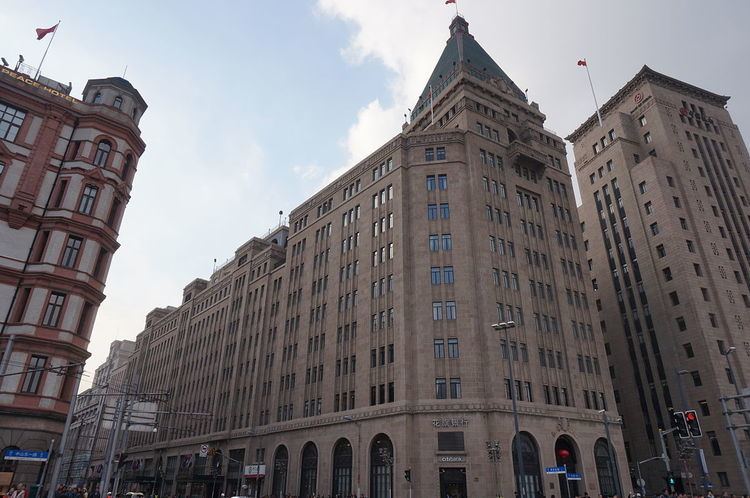Opening 1956 Floor count 13 | Number of rooms 270 | |
 | ||
Management | ||
The Peace Hotel (Chinese: 和平饭店) is a hotel on The Bund in Shanghai, China, which overlooks the surrounding areas. The hotel has two different buildings. The Sassoon House, originally housed the Cathay Hotel and is today the Fairmont Peace Hotel run by Fairmont Hotels and Resorts of Canada. The South Building was built as the Palace Hotel and is today the Swatch Art Peace Hotel. The two buildings both face the Bund, but are divided by Nanjing Road.
Contents
North Building
The larger North Building is called Sassoon House. The building was built by Sir Victor Sassoon, of the Sassoon family, which built a Shanghai business and real estate empire in the early 20th century. He was a British Sephardic Jew of Iraqi origin, educated at Harrow School and Cambridge University. His family managed extensive business holdings in Hong Kong, Shanghai, and Calcutta. Sassoon House was the first high-rise building built by Victor Sassoon, and one of the first skyscrapers in the Eastern Hemisphere. It was designed by architects Palmer and Turner, with a reinforced concrete structure. Construction began in 1926, and was completed in 1929.
The building occupies 4,617 square meters (15,148 square feet), and offers 36,317 square meters (119,150 square feet) of floor space. The building is ten stories in height, and the tenth floor is a penthouse, where Victor Sassoon once lived. The North Building is 77 meters (253 feet) high to the roofline, and 83 meters (272 feet) to the spire.
The builders followed a consistent art deco scheme, from exterior design to interior decor. Most of the building features granite facing, while the ninth floor and the roof are surfaced with terracotta. The eastern facade (facing the Huangpu River and the Bund) features a pyramidal roof with steep sides, and a height of about 10 meters (33 feet). The pyramid is faced with copper, which has corroded to light green.
Banks and shops leased the ground floor space until 1949. This space became the Shanghai branch of Citibank in 2002. The fourth through ninth floors once housed the Cathay Hotel.
After the Communist takeover in 1949, some of the offices were used by the Municipal Finance Committee. In 1952, the building was taken over by the Municipal Government. In 1956, it once again became a hotel under the name "Peace Hotel". During the Cultural Revolution, the hotel was used by the Gang of Four, most famously by Zhang Chunqiao as he headed the Shanghai Commune from headquarters in the Peace Hotel.
Its Old Jazz Band was recently the basis for a movie, "As Time Goes By" a film by Uli Gaulke. Its roof terrace restaurant overlooks the district of Pudong across the Huangpu.
In 2007, the hotel closed for a three-year renovation of both the exterior and interior, including the guest rooms, the lobby, and the dining and entertainment venues. The North Building reopened in 2010, as the Fairmont Peace Hotel Shanghai. The hotel now offers 270 guestrooms and 39 suites, including Victor's Café, named for Sir Victor Sassoon. The eighth floor hosts the Peace Hall, plus several meeting rooms, and an outdoor terrace.
A low-rise extension has been added to the rear of the hotel, housing guestrooms, a swimming pool, and spa.
South Building
Separated from the North Building by Nanjing Road, the South Building dates back to the 1850s, when it was known as the Central Hotel. In 1903, the hotel was restructured and renamed the Palace Hotel. The building that stands today was completed in 1908, and offered two elevators, the first building in Shanghai to do so. It was also once home to a Kuhn & Komor shop.
The hotel occupies 2,125 square meters (6,972 square feet), with a floor space of 11,607 square meters (38,081 square feet). It has a brick veneer, with its six stories reaching 30 metres (98 ft) in height. The exterior is in a Renaissance style. The hotel has eighteen artist residences and seven guest rooms.
In 1911, after the success of the Xinhai Revolution, Sun Yat-sen stayed at the hotel and advocated commitment to the revolutionary cause. During World War II, the building was occupied by the Japanese army. In 1947 it was purchased by a Chinese company. After the revolution in 1949, it continued operations until 1952, when it was confiscated and used by the Municipal Construction Department. In 1965 it resumed operations as a hotel, as a wing of the Peace Hotel.
Similar to its counterpart to the north, the South Building was renovated in preparation for the 2010 World Expo. It emerged as the Swatch Art Peace Hotel. It hosts artists from around the world who live and work for a limited time in apartments/workshops. The heritage facade and public rooms of the building have been restored.
